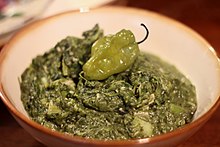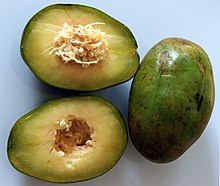
Costa Rican cuisine is known for being mostly mild, with high reliance on fruits and vegetables. Rice and black beans are a staple of most traditional Costa Rican meals, often served three times a day. Costa Rican fare is nutritionally well rounded, and nearly always cooked from scratch from fresh ingredients. Owing to the location of the country, tropical fruits and vegetables are readily available and included in the local cuisine.
Jamaican cuisine includes a mixture of cooking techniques, flavours and spices influenced by Amerindian, African, Irish, English, French, Portuguese, Spanish, Indian, Chinese and Middle Eastern people who have inhabited the island. It is also influenced by the crops introduced into the island from tropical Southeast Asia, many of which are now grown locally. A wide variety of seafood, tropical fruits and meats are available.

Trinidad and Tobago has a unique history and its food is influenced by Indian-South Asian, West African, Creole, European, American, Chinese, Amerindian, and Latin American culinary styles. Trinidadian and Tobagonian food is dominated by a wide selection of dishes, most notably, doubles, pelau, callaloo and curried crab and dumplings. Trinidad and Tobago is also known for its prepared provisions, such as dasheen, sweet potato, eddoes, cassava, yam, soups and stews, also known as blue food across the country. Corresponding to the Blue Food Day event held annually in Trinidad and Tobago.

Sri Lankan cuisine is known for its particular combinations of herbs, spices, fish, vegetables, rices, and fruits. The cuisine is highly centered around many varieties of rice, as well as coconut which is a ubiquitous plant throughout the country. Seafood also plays a significant role in the cuisine, be it fresh fish or preserved fish. As a country that was a hub in the historic oceanic silk road, contact with foreign traders brought new food items and cultural influences in addition to the local traditions of the country's ethnic groups, all of which have helped shape Sri Lankan cuisine. Influences from Indian, Indonesian and Dutch cuisines are most evident with Sri Lankan cuisine sharing close ties to other neighbouring South and Southeast Asian cuisines.

Callaloo is a plant used in popular dishes in many Caribbean countries, while for other Caribbean countries, a stew made with the plant is called callaloo. Cuisines including the plant Callaloo or dishes called callaloo varies throughout the Caribbean. Countries like Jamaica and Belize refer to an indigenous green leaf vegetable, Caribbean amaranth, as callaloo. In countries such as Trinidad and Tobago or Grenada, the dish itself is called callaloo, and uses taro leaves or Xanthosoma leaves.

Iraqi cuisine is a Middle Eastern cuisine that has its origins in the ancient Near East culture of the fertile crescent. Tablets found in ancient ruins in Iraq show recipes prepared in the temples during religious festivals—the first cookbooks in the world. Ancient Mesopotamia was home to a sophisticated and highly advanced civilization, in all fields of knowledge, including the culinary arts.
The Culture of Saint Lucia blends the influences of African, French, and English heritage. The official language of the island is English but kwéyèol(creole) and English creole, a form of French patois, remains an influential secondary language. The people are predominantly Catholic but the religious climate is tolerant.

Peranakan cuisine or Nyonya cuisine comes from the Peranakans, descendants of early Chinese migrants who settled in Penang, Malacca, Singapore and Indonesia, inter-marrying with local Malays. In Baba Malay, a female Peranakan is known as a nonya, and a male Peranakan is known as a baba. The cuisine combines Chinese, Malay, Javanese, South Indian, and other influences.

Colombian cuisine is a compound of the culinary traditions of the six main regions within Colombia. Colombian cuisine varies regionally and is particularly influenced by Indigenous Colombian, Spanish, and African cuisines, with slight Arab influence in some regions. As one of the most biodiverse countries in the world, Colombia has one of the widest variety of available ingredients depending on the region.

Dominican cuisine is made up of Spanish, indigenous Taíno, Middle Eastern and African influences. The most recent influences in Dominican cuisine are from the British West Indies and China.
Bhojpuri cuisine is a style of food preparation common among the Bhojpuri people of Bihar and eastern Uttar Pradesh in India, and also the Terai region of Nepal. Bhojpuri foods are mostly mild and tend to be less hot in terms of spices used. The cuisine consists of both vegetable and meat dishes.
Jounen Kwéyòl is celebrated in the Caribbean islands of Dominica and Saint Lucia, on the last Friday of October and the last Sunday of October respectively and has been held annually since 1984. Throughout the preceding week, the various towns on both islands host cultural events and festivals which showcase different elements of their heritage and culture.
Dominica cuisine is the cuisine of the island nation of Dominica. The cuisine is rooted in creole techniques with local produce flavored by spices found on the island. Dominican cuisine is a mixture of indigenous Kalinago, African, French, and English influences.

Belizean cuisine is an amalgamation of all ethnicities in the nation of Belize and their respectively wide variety of foods. Breakfast often consists of sides of bread, flour tortillas, or fry jacks that are often homemade and eaten with various cheeses. All are often accompanied with refried beans, cheeses, and various forms of eggs, etc. Inclusive is also cereal along with milk, coffee, or tea.

The cuisine of Equatorial Guinea is a blend of the cuisines of the native peoples of this African country, including the Annobonese, the Bubi, the Fang, and the Kombe. It is also influenced by the cuisines of Spain ; other African nations such as Nigeria and Cameroon; Islamic states such as Morocco; and Creole cuisine overall. Its cuisine incorporates various meats, including game and bushmeat as well as imports, and is known for its strong flavors and high spice levels. Fish and chicken are common dishes.
Bahamian cuisine refers to the foods and beverages of The Bahamas. It includes seafood such as fish, shellfish, lobster, crab, and conch, as well as tropical fruits, rice, peas, pigeon peas, and pork. Popular seasonings commonly used in dishes include chilies, lime, tomatoes, onions, garlic, allspice, ginger, cinnamon, rum, and coconut. Rum-based beverages are popular on the islands. Since the Bahamas consist of a multitude of islands, notable culinary variations exist.

Seychellois cuisine is the cuisine of the Republic of Seychelles, an archipelago country consisting of 115 islands. Fish plays a prominent part in country's cuisine because of its location in the Indian Ocean. The Seychelles's cuisine has been influenced by African, British, French, Spanish, Indian and Chinese cuisines.
Barbadian cuisine, also called Bajan cuisine, is a mixture of African, Portuguese, Indian, Irish, Creole, Indigenous and British background. A typical meal consists of a main dish of meat or fish, normally marinated with a mixture of herbs and spices, hot side dishes, and one or more salads. The meal is usually served with one or more sauces.

Sambal is an Indonesian chilli sauce or paste, typically made from a mixture of a variety of chilli peppers with secondary ingredients such as shrimp paste, garlic, ginger, shallot, scallion, palm sugar, and lime juice. Sambal is an Indonesian loanword of Javanese origin. It originated from the culinary traditions of Indonesia and is also an integral part of the cuisines of Singapore, Malaysia, Brunei, and Sri Lanka. It has also spread through overseas Indonesian populations to the Netherlands and Suriname.















